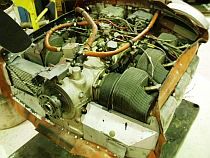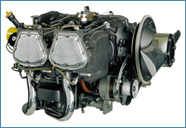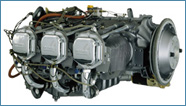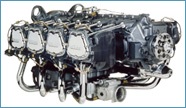Bush Plane Piston Engines
Here's a very brief description of the engines that power the bush-planes on our site. We'll throw in some nomenclature and then list them alphabetically by manufacturer:
Piston engine nomenclature:
O= opposed (as opposed to v block or radial) I= fuel injected T or TS= turbocharged G= geared H or V or HV= Helicopter or vertical installation (as happens in some helicopters) R= Radial The first number after the letters of an engine refers to the cubic displacement. Numbers or letters after the first number tend to be company model numbers (e.g. IO-520-BA, is a specific model of the IO-520 engine family). Franklin engines did not necessarily follow the above nomenclature.
Thus a 0-540 is an opposed engine of 540 cubic inches displacement, a TIO-540 engine is a turbocharged, fuel injected, opposed engine and the cubic displacement is 540 inches. A GTSIO-520 is a geared, turbo supercharged (an archaic an technically incorrect term, that is nevertheless still used), fuel injected opposed engine of 520 cubic inches. R-985 refers to a radial design of 985 cubic inches (radials, being older engines typically, don't include references for turbo charging, fuel injection or geared).
Jet engines, turboprops and turbo shafts (helicopter turbine engines) do not follow any standard nomenclature, a J-85 is an engine (military) made by General Electric and is the equivalent of the engines used on early models of civilian Learjets (and others). Nothing in the “J-85” designation tells you about power, design, features or usage unlike piston engine nomenclature.
Because we've described the nomenclature for piston engines, we'll omit the specific references to fuel injection, turbo charging and the like in the following discussion and simply refer to the engines a 'O' somethings, even though it's unlikely Continental has ever made an "O-550" but they have made hundreds of "IO-550s." We do this for simplicity because whether a plane's engine has fuel injection or not, rarely affects whether the engine itself is a good engine. Also there are tons of planes out there that share a common engine series, even though the particular engine in the series changes numerous times during the production run of the aircraft. We also don't attempt to describe all the aircraft that feature these engines, just the ones on bush-planes.com.
Continental 0-470, 0-520/550 Series

The Continental O-470 powers some models of the Cessna 182, 180, 185 (early models), 205 and Bear hawk. It generally produces between 225-260 horsepower. It is a six cylinder design that is often fuel injected and sometimes turbocharged. Its bigger brother the 0-520 and 0-550 engines are likewise typically fuel-injected and sometimes turbocharged. The 520/550 engines are used on Cessna 185s, 206s, and 207s. They generally produce between 285-310 horsepower. Continental has made these engines for years and they have a solid reputation for dependability but do not have the longevity that the smaller Lycoming engines have.
Franklin
Franklin 6A4-165 powers the Stinson 108 6A8-215 powers the Seabee Franklin 0-335 powers Some Hiller helicopters and some Bell 47s. Franklin is a line of engines with a difficult past. They sold well after the Second World War and were in many different airplanes and helicopters. Some people swear by them and some people cuss them. The company was bought in 1975 by the Polish company PZL and so parts—according to some—are still available.
Garrett AiResearch TPE-331

The Garrett AiResearch TPE-331 is a turboprop engine originally designed by AiResearch and now produced by Honeywell. It was designed to be both a turbo shaft (TSE331) and a turboprop (TPE331), but the turbo shaft version never went into production; however, over 14,000 TPE331s have been sold since the first engine was produced in 1963. The military version is the T76. It powered early versions of the Short Skyvan as well as turbine versions of the homebuilt Sherpa. It is a reliable engine well liked by many operators.
Lycoming 0-320, 0-360 Series

These flat, four cylinder engines produce between 150-200 horsepower normally, are often fuel injected and may be turbocharged. They power some Cessna 170s, 172s Super Cubs, Maules, Champs, Citabrias, Huskies, Murphy homebuilts, Artic Terns, Mountain Goats, Robinson R-22s BushCaddys, Enstroms, Schweizers, Safari Helicopters, Zeniths, Glastars, Avids and Kitfoxes. These engines are by far the best light plane aero engines ever made which explains why they are in practically all the airplanes and many of the helicopters on bush-planes.com. Time between overhaul (TBO) for these engines, depending on specific model is usually in excess of 2,000 hours and these engines quite easily exceed these TBO figures handsomely under normal conditions. As a testament to the reliability of these engines, they are often featured in training aircraft where students spend all day giving them full power and then cutting them back to zero (as is down in touch-and-go training). There are not too many engines that will put up with this treatment as well as the little Lycoming engines.
This was a helicopter engine which powered some versions of the Hiller 12 and Bell 47. Information is scarce on this engine. Versions of this engine made their way into early Bellancas and Aero Commanders, a geared version, the GO-435 was also made.
Lycoming 0-540

These are flat, six cylinder engines that produce (typically) between 250-300 horsepower. They power some Cessna 206s, the Piper Aztec, some Maules and Murphy Moose's, Bearhawks and the Gippsland GA8. These engines are outgrowths of the hugely reliable 0-320/0-360 series and like their littler brothers, they are often fuel injected and may be turbocharged. They typically will not go all long between overhaul as the smaller Lycomings and some consider them not to be as dependable as the little Lycomings, a complaint some level against the larger Continental engines too. Nevertheless, both the large Lycomings and Continental series have great reputations as dependable and reliable engines.
Lycoming 0-720

This is a rarity in the world of aero engines, it's a flat, eight cylinder engine that produces 400 horsepower in most forms. It can be turbocharged and fuel injected. It powers the Sherpa homebuilt. If you took to 0-360 Lycomings that produced 200 hp each, and bolted them together you'd have an engine of 720 cubic inches that produces 400 hp (it's nice how the math all worked out on this one!). The actual 0-720 engine was a little more complicated than all this, but that was the basic idea behind it. Very few airplanes ever used this engine (Comanche 400s, some Queen Airs, Twin Bonanza and Aero Commander conversions and some crop dusters). Reportedly rear cylinder cooling can be a problem on this large engine.
Pratt & Whitney R-985

Here's an old school radial that is a great engine even by today's standards. The R-985 is a nine cylinder radial engine that typically produces 450 horsepower. It powers the Beech 18 and the deHavilland Beaver. Even though the R-985 hasn't been made in years, parts are still available for it. The R-985 typically has a TBO of 1500-1800 hours, but like the smaller Lycomings, it is well known for going beyond its TBO. This engine was also known as the "Wasp Junior".
Pratt & Whitney R-1340

This is the famous "Wasp" engine which was featured on many famous World War Two era aircraft. It powers the deHavilland Otter and by implication, the AN-2 as well, as the Shvetsov engine was a licensed built version the same engine. The Russians did make some changes to their engines, but today some countries have granted authority to substitute the original Pratt & Whitney Wasps with Shvetsov engines. The 1340 Wasps produced between 400-600 horsepower typically. These engines are nine cylinder radial engines. The Wasp engines were, and still are, renowned for their dependability. Other, larger versions of this engine, regularly had entire cylinder head assemblies shot off in the Second World War and the engine would continue to run, albeit it roughly. When pilots get shot at and cylinders get blown off their engine and yet the engine still brings them home, a certain affection forms in the pilot's heart toward the engine. Consequently, young bucks are strongly advised not to run the Wasp engines down in front of old-timers.
Pratt & Whitney PT-6

The Pratt & Whitney PT-6 is one of the best aero engines ever made, it has been made for a long time and has powered numerous aircraft. It powers Cessna Caravans, turbine deHavilland Beavers, Twin Otters, turbine Otters, and Dash 7s. The PT-6 family is very large with engines producing 450 shp (shaft horsepower) to nearly 2,000 shp. TBOs on these engines are on the order of 8,000 hours, but piston engine owners need not become too envious, overhauling a PT-6 costs in the range of six-figures.
Shevetsov ASh-62 Engine

The Shvetsov ASh-62 (designated M-62 before 1941) is a nine-cylinder, air-cooled, radial aircraft engine produced in the Soviet Union. It was a development of the Wright Cyclone that had been built there under licence as the M-25, the main improvements including a two-stage supercharger and a more efficient induction system. Power was increased from the Cyclone's 775 hp to 1,000 hp. First run in 1937, licenced versions are still in production by WSK "PZL-Kalisz" in Poland as the ASz-62 (as of 2007). The Ash-62 was also produced in China. It is estimated that 40,361 were produced in the USSR.
Turbomeca Astazou
The French Turboméca Astazou was a successful series of turboprop and turbo shaft engines, first run in 1957. The original version weighed 110 kg (240 lb) and developed 240 kW (320 shp) at 40,000 rpm. It powered the first version of the Short Skyvan series, the SC-7. Many of these were made into turbo-shafts that powered helicopters.
Vedeneyev M-14P

Here's a Russian nine cylinder radial engine that was designed in the 1930s. It's been around forever, has been made in greater numbers than all the engines Lycoming and Continental ever produced and is very dependable. Horsepower is 360-450. This engine powers the Murphy Moose. A predecessor to this engine powered the Yak-12s.
Wright R-1820 Cyclone Nine

This is a nine cylinder radial engine that produced between 575 to 1,425 horsepower depending upon model and whether the engine was supercharged. It was produced in large numbers during the Second World War and continued production until the 1950's. It was featured in such famous aircraft as early models of the Douglas DC-3, Boeing B-17 and Lockheed Lodestar. According to some sources, it was copied by the Russians for their 1000-horsepower 9-cylinder Shvetsov ASh-62 which powered the AN-2. Caterpillar converted this engine to diesel and it was used in some US Army tank designs, most notably the M4A6 Sherman Tank.
Believe it or not, we were able to locate a hilarious video that explains how a piston engine works. Seriously, you will get a good laugh. We aren't joking.